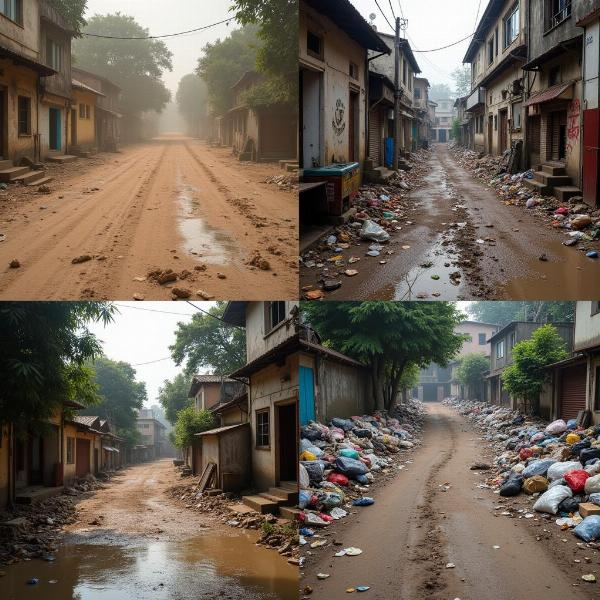Grime meaning in Hindi encompasses various words depending on the context and the specific type of dirt or filth being referred to. Understanding these nuances is key to accurately translating and interpreting the concept of grime. This article explores the different ways to express “grime” in Hindi, delving into cultural contexts and providing practical examples to help you grasp the subtle differences between these terms.
Different Ways to Say “Grime” in Hindi
Several Hindi words can convey the meaning of “grime,” each with its own shade of meaning:
- मैल (mail): This is perhaps the most common and versatile term for grime. It refers to general dirt or uncleanliness, often accumulated over time. Think of the grime that builds up on clothes, dishes, or even skin after a day’s work.
- गंदगी (gandagi): This word signifies dirtiness and filth, often associated with unsanitary conditions. It can describe the grime found in a neglected area or the general state of being unclean.
- कचरा (kachra): This translates to “garbage” or “rubbish.” While not directly synonymous with grime, it can be used in contexts where grime is a result of accumulated waste.
- धूल (dhool): Meaning “dust,” this word describes a specific type of grime – fine, dry particles of dirt.
- कीचड़ (keechad): This word denotes “mud” or “sludge,” a thicker, wetter form of grime often found outdoors.
 Grime Examples in India
Grime Examples in India
Cultural Context of Grime in India
In India, cleanliness holds significant cultural and religious importance. Concepts like safai (cleanliness) and suchita (purity) are deeply ingrained in the Indian way of life. This emphasis on cleanliness influences how grime is perceived and dealt with. For instance, the act of cleaning before entering a home or a temple is a common practice rooted in the belief of maintaining purity.
Practical Examples of “Grime” in Hindi
Understanding the context is key to choosing the right Hindi word for grime. Here are some examples:
- “The grime on the kitchen counter needs to be wiped.” – रसोई के काउंटर पर मैल को पोंछने की ज़रूरत है। (rasoi ke counter par mail ko ponchhne ki zarurat hai.)
- “The streets were covered in grime after the monsoon.” – मानसून के बाद सड़कें कीचड़ से ढकी हुई थीं। (mansoon ke baad sadken keechad se dhaki hui thin.)
- “The grime and pollution in the city are affecting air quality.” – शहर में गंदगी और प्रदूषण हवा की गुणवत्ता को प्रभावित कर रहे हैं। (shahar mein gandagi aur pradushan hawa ki gunvatta ko prabhavit kar rahe hain.)
Grime and Its Implications
The presence of grime can have several implications, including health concerns, environmental issues, and social perceptions. Understanding these implications further emphasizes the importance of cleanliness and sanitation.
What does grime symbolize?
Grime can symbolize neglect, decay, and a lack of hygiene. It can also represent the challenges posed by pollution and environmental degradation.
What are the health risks associated with grime?
Exposure to grime can lead to various health problems, including respiratory infections, skin allergies, and gastrointestinal illnesses.
Conclusion: Navigating the Nuances of “Grime” in Hindi
Understanding the different Hindi words for grime allows for more accurate communication and a deeper understanding of Indian culture. Whether you’re translating a document, having a conversation, or simply learning about the language, knowing the nuances of these terms will enhance your understanding. Remember to consider the context and the specific type of dirt being described to choose the most appropriate word.
FAQ
- What is the most common Hindi word for grime? Mail (मैल) is the most common and versatile term.
- How does Indian culture view cleanliness? Cleanliness holds significant cultural and religious importance in India.
- What are the health risks associated with grime? Grime can lead to respiratory infections, skin allergies, and gastrointestinal illnesses.
- What is the difference between gandagi and kachra? Gandagi refers to general dirtiness, while kachra means garbage or rubbish.
- What word describes dust in Hindi? Dhool (धूल) means dust.
Meaning-Hindi.in is your trusted partner for professional Hindi translation services. We offer a comprehensive range of solutions, including business and commercial document translation, certified and legal document translation, technical and user manual translation, website and localization services, educational and academic document translation, and express translation services. Our expert linguists ensure accuracy and cultural sensitivity in every project. Contact us today for your Hindi translation needs at [email protected] or call us at +91 11-4502-7584. Meaning-Hindi.in is your one-stop solution for all your Hindi translation requirements.